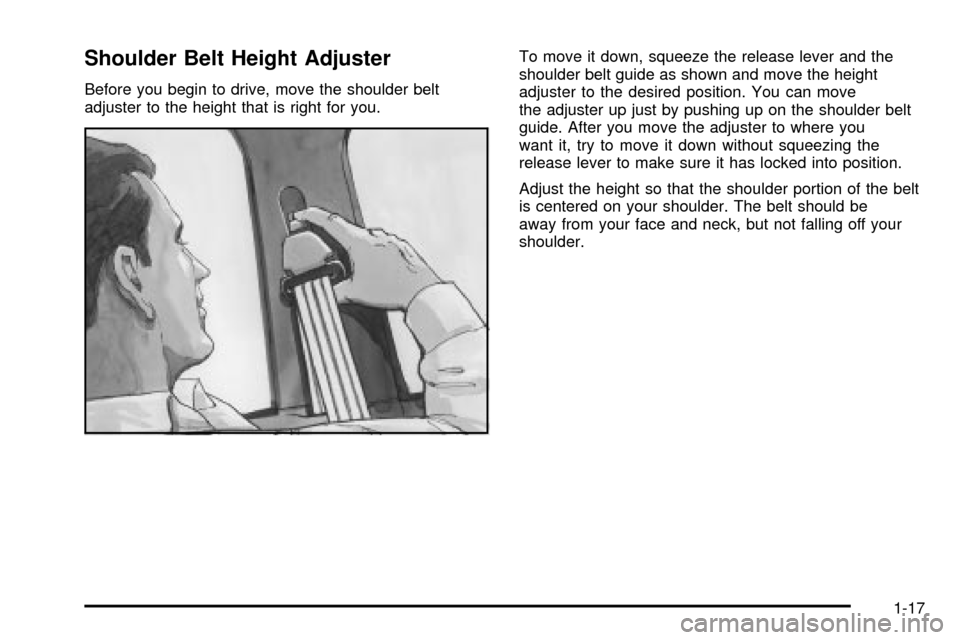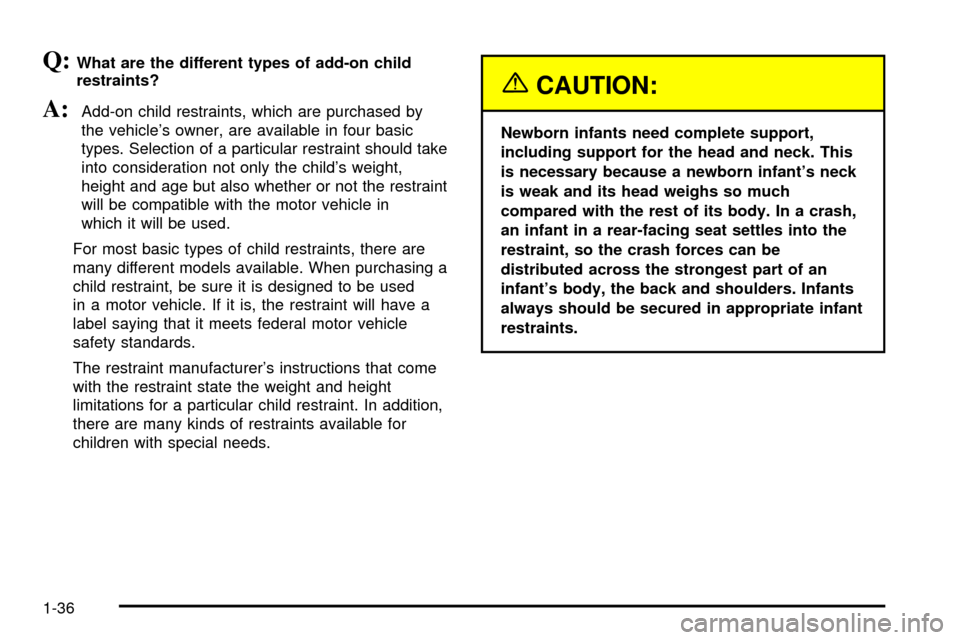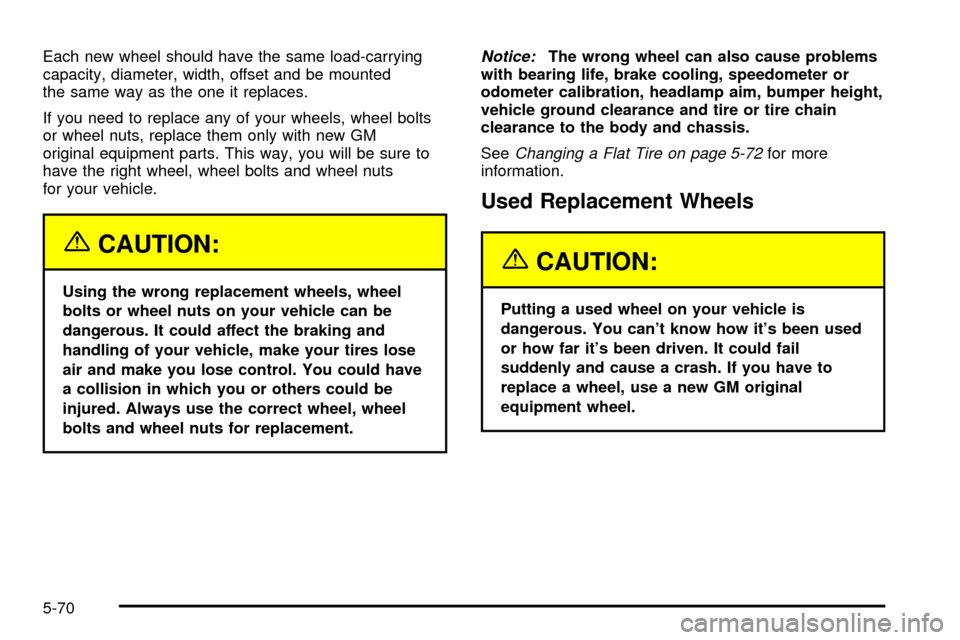2003 CHEVROLET IMPALA height
[x] Cancel search: heightPage 23 of 408

Shoulder Belt Height Adjuster
Before you begin to drive, move the shoulder belt
adjuster to the height that is right for you.To move it down, squeeze the release lever and the
shoulder belt guide as shown and move the height
adjuster to the desired position. You can move
the adjuster up just by pushing up on the shoulder belt
guide. After you move the adjuster to where you
want it, try to move it down without squeezing the
release lever to make sure it has locked into position.
Adjust the height so that the shoulder portion of the belt
is centered on your shoulder. The belt should be
away from your face and neck, but not falling off your
shoulder.
1-17
Page 42 of 408

Q:What are the different types of add-on child
restraints?
A:Add-on child restraints, which are purchased by
the vehicle's owner, are available in four basic
types. Selection of a particular restraint should take
into consideration not only the child's weight,
height and age but also whether or not the restraint
will be compatible with the motor vehicle in
which it will be used.
For most basic types of child restraints, there are
many different models available. When purchasing a
child restraint, be sure it is designed to be used
in a motor vehicle. If it is, the restraint will have a
label saying that it meets federal motor vehicle
safety standards.
The restraint manufacturer's instructions that come
with the restraint state the weight and height
limitations for a particular child restraint. In addition,
there are many kinds of restraints available for
children with special needs.
{CAUTION:
Newborn infants need complete support,
including support for the head and neck. This
is necessary because a newborn infant's neck
is weak and its head weighs so much
compared with the rest of its body. In a crash,
an infant in a rear-facing seat settles into the
restraint, so the crash forces can be
distributed across the strongest part of an
infant's body, the back and shoulders. Infants
always should be secured in appropriate infant
restraints.
1-36
Page 304 of 408

Brake Pedal Travel
See your dealer if the brake pedal does not return to
normal height, or if there is a rapid increase in
pedal travel. This could be a sign of brake trouble.
Brake Adjustment
Every time you apply the brakes, with or without the
vehicle moving, your brakes adjust for wear.
Replacing Brake System Parts
The braking system on a vehicle is complex. Its many
parts have to be of top quality and work well together if
the vehicle is to have really good braking. Your
vehicle was designed and tested with top-quality GM
brake parts. When you replace parts of your braking
system Ð for example, when your brake linings
wear down and you need new ones put in Ð be sure
you get new approved GM replacement parts. If
you don't, your brakes may no longer work properly. For
example, if someone puts in brake linings that are
wrong for your vehicle, the balance between your front
and rear brakes can change Ð for the worse. The
braking performance you've come to expect can change
in many other ways if someone puts in the wrong
replacement brake parts.
Battery
Your new vehicle comes with a maintenance free
ACDelcožbattery. When it's time for a new battery, get
one that has the replacement number shown on the
original battery's label. We recommend an ACDelco
ž
battery. SeeEngine Compartment Overview on
page 5-12for battery location.
Warning:Battery posts, terminals and related
accessories contain lead and lead compounds,
chemicals known to the State of California to cause
cancer and reproductive harm. Wash hands
after handling.
5-48
Page 326 of 408

Each new wheel should have the same load-carrying
capacity, diameter, width, offset and be mounted
the same way as the one it replaces.
If you need to replace any of your wheels, wheel bolts
or wheel nuts, replace them only with new GM
original equipment parts. This way, you will be sure to
have the right wheel, wheel bolts and wheel nuts
for your vehicle.
{CAUTION:
Using the wrong replacement wheels, wheel
bolts or wheel nuts on your vehicle can be
dangerous. It could affect the braking and
handling of your vehicle, make your tires lose
air and make you lose control. You could have
a collision in which you or others could be
injured. Always use the correct wheel, wheel
bolts and wheel nuts for replacement.
Notice:The wrong wheel can also cause problems
with bearing life, brake cooling, speedometer or
odometer calibration, headlamp aim, bumper height,
vehicle ground clearance and tire or tire chain
clearance to the body and chassis.
See
Changing a Flat Tire on page 5-72for more
information.
Used Replacement Wheels
{CAUTION:
Putting a used wheel on your vehicle is
dangerous. You can't know how it's been used
or how far it's been driven. It could fail
suddenly and cause a crash. If you have to
replace a wheel, use a new GM original
equipment wheel.
5-70
Page 405 of 408

Seat............................................................... 1-6
Head Restraints............................................ 1-6
Seats.............................................................. 1-4
Heated Seats............................................... 1-4
Manual Lumbar............................................. 1-3
Manual........................................................ 1-2
Reclining Seatbacks...................................... 1-4
Six-Way Power Seats.................................... 1-3
Split Folding Rear Seat.................................. 1-7
Securing a Child Restraint................................1-45
Designed for the LATCH System...................1-45
Rear Seat Position......................................1-45
Right Front Seat Position..............................1-48
Service Bulletins.............................................7-11
Service Manuals.............................................7-11
Service........................................................... 5-3
Adding Equipment to the Outside
of Your Vehicle.......................................... 5-4
Doing Your Own Work................................... 5-4
Engine Soon Light.......................................3-37
Message....................................................3-46
Publications Ordering Information...................7-11
Traction System Warning Message.................3-41
Vehicle Soon Message.................................3-48
Setting Preset Stations....................3-56, 3-66, 3-78
Setting the Time.............................................3-53
Setting the Tone (Bass/Treble)..........3-57, 3-67, 3-79
SETTINGS (Display Current Settings)................2-45
Sheet Metal Damage.......................................5-90
Shifting Into Park (P).......................................2-27Shifting Out of Park (P)...................................2-30
Shoulder Belt Height Adjuster...........................1-17
Skidding........................................................4-15
Some Other Rainy Weather Tips.......................4-19
Special Fabric Cleaning Problems.....................5-86
Speci®cations, Capacities...............................5-103
Speedometer..................................................3-31
Split Folding Rear Seat..................................... 1-7
Starter Switch Check.......................................6-12
Starting Your 3400 V6 Engine...........................2-20
Starting Your 3800 Series II V6 Engine..............2-21
Starting Your Engine.......................................2-19
Steering Column Shift Lever.............................2-28
Steering in Emergencies..................................4-11
Steering, Suspension and Front Drive Axle
Boot and Seal Inspection..............................6-14
Steering Tips..................................................4-10
Steering Wheel Controls, Audio.........................3-90
Steering........................................................4-10
Storage Areas................................................2-43
Center Console Storage Area........................2-43
Convenience Net.........................................2-43
Front Storage Area......................................2-43
Glove Box..................................................2-43
Rear Storage Area.......................................2-43
Storing the Flat Tire and Tools..........................5-81
Storing the Spare Tire and Tools.......................5-83
Stuck in Sand, Mud, Ice or Snow......................4-30
Sun Visors.....................................................2-15
Sunroof.........................................................2-44
13